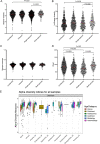Helminth-Induced Human Gastrointestinal Dysbiosis: a Systematic Review and Meta-Analysis Reveals Insights into Altered Taxon Diversity and Microbial Gradient Collapse
- PMID: 34933444
- PMCID: PMC8689561
- DOI: 10.1128/mBio.02890-21
Helminth-Induced Human Gastrointestinal Dysbiosis: a Systematic Review and Meta-Analysis Reveals Insights into Altered Taxon Diversity and Microbial Gradient Collapse
Abstract
High-throughput 16S rRNA sequencing has allowed the characterization of helminth-uninfected (HU) and helminth-infected (HI) gut microbiomes, revealing distinct profiles. However, there have been no qualitative or quantitative syntheses of these studies, which show marked variation in participant age, diet, pathogen of interest, and study location. A predefined minimally biased search strategy identified 23 studies in humans. For each of these studies, we qualitatively addressed the effects of helminth infection on within-individual (alpha) and between-individual (beta) fecal microbiome diversity, infection-associated microbial taxa, the effect of helminth clearance on microbiome composition, microbiome composition as a predictor of infection status or treatment outcome, and treatment-specific effects on the fecal microbiome. Concomitantly, we performed a meta-analysis on a subset of 7 of these studies containing raw, paired-end 16S reads and individual-level metadata, comprising 424 pretreatment or untreated HI individuals and 497 HU controls. After reducing the batch effect and adjusting for age, our data demonstrated that intestinal helminth parasites can alter the host gut microbiome by increasing alpha diversity and promoting taxonomic reassortment and gradient collapse. Most strongly influencing the microbiome composition were the helminths found in the large intestine, Enterobius vermicularis and Trichuris trichiura, suggesting that this influence appears to be specific to soil-transmitted helminths (STH) species and host anatomical niche. In summary, using a large and diverse sample set captured in the meta-analysis, we were able to evaluate the influence of individual helminth species as well as species-species interactions, each of which explained a significant portion of the variation in the microbiome. IMPORTANCE The gut microbiome has established importance in regulating many aspects of human health, including nutrition and immunity. While many internal and environmental factors are known to influence the microbiome, less is known about the effects of intestinal helminth parasites (worms), which together affect one-sixth of the world's population. Through a comprehensive qualitative systematic review and quantitative meta-analysis of existing literature, we provide strong evidence that helminth infection dynamically shifts the intestinal microbiome structure. Moreover, we demonstrated that such influence seems to be specific to helminth species and host anatomical niche. Our findings suggest that the gut microbiome may underlie some of the pathology associated with intestinal worm infection and support future work to understand the precise nature of the helminth-microbiome relationship.
Keywords: helminth; intestinal bacteria; intestinal parasites; microbiome; nematodes; soil-transmitted helminth.
Conflict of interest statement
The authors declare no conflict of interest.
Figures







References
-
- Mireku MO, Boivin MJ, Davidson LL, Ouédraogo S, Koura GK, Alao MJ, Massougbodji A, Cot M, Bodeau-Livinec F. 2015. Impact of helminth infection during pregnancy on cognitive and motor functions of one-year-old children. PLoS Negl Trop Dis 9:e0003463. doi:10.1371/journal.pntd.0003463. - DOI - PMC - PubMed
-
- Bartsch SM, Hotez PJ, Hertenstein DL, Diemert DJ, Zapf KM, Bottazzi ME, Bethony JM, Brown ST, Lee BY. 2016. Modeling the economic and epidemiologic impact of hookworm vaccine and mass drug administration (MDA) in Brazil, a high transmission setting. Vaccine 34:2197–2206. doi:10.1016/j.vaccine.2016.03.018. - DOI - PMC - PubMed
-
- Pabalan N, Singian E, Tabangay L, Jarjanazi H, Boivin MJ, Ezeamama AE. 2018. Soil-transmitted helminth infection, loss of education and cognitive impairment in school-aged children: a systematic review and meta-analysis. PLoS Negl Trop Dis 12:e0005523. doi:10.1371/journal.pntd.0005523. - DOI - PMC - PubMed
Publication types
MeSH terms
LinkOut - more resources
Full Text Sources

